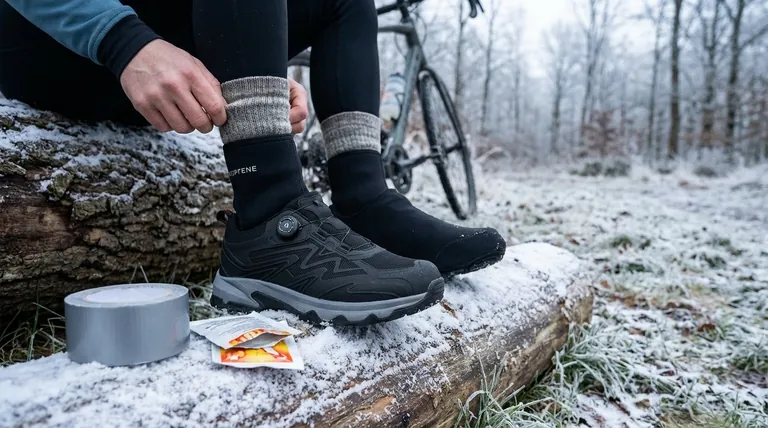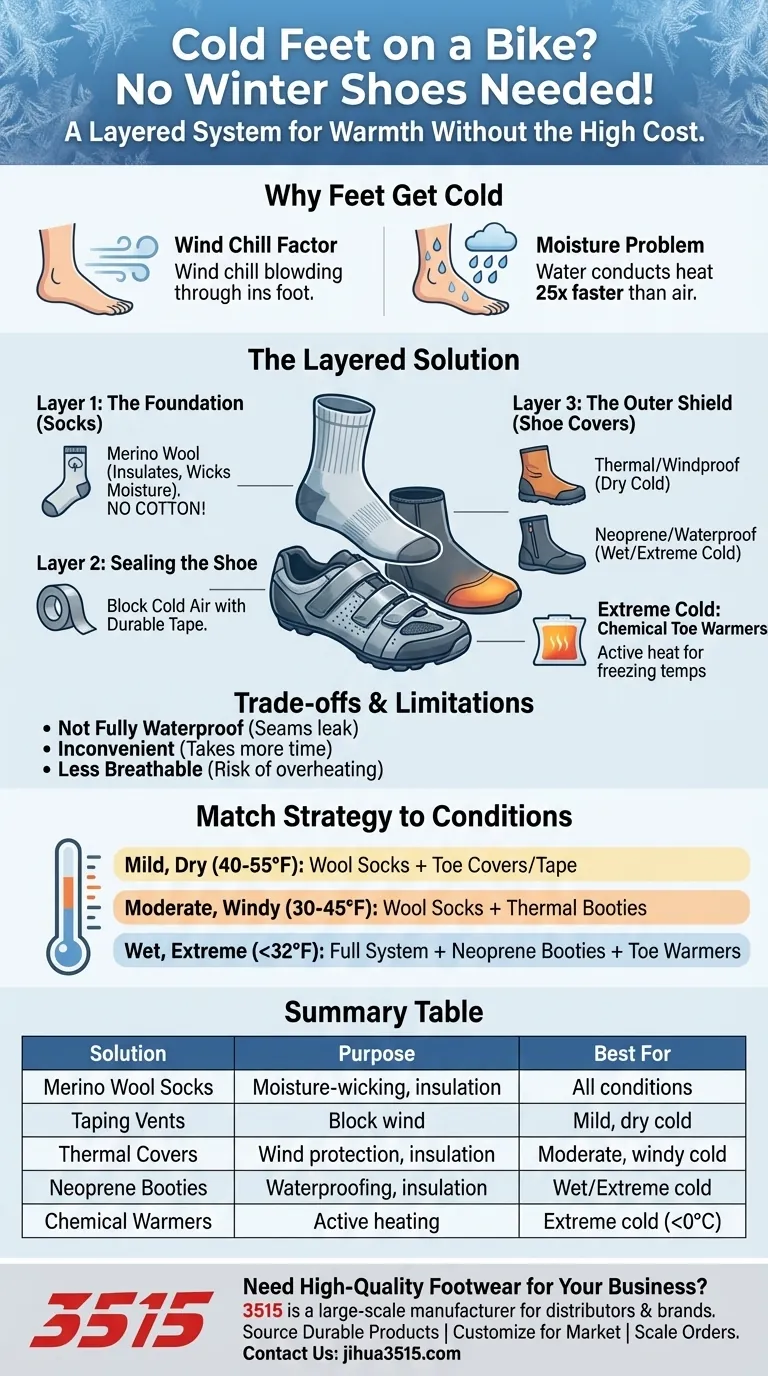To protect your feet from cold without expensive winter shoes, the most effective strategies involve creating a layered system. This includes using insulated or waterproof shoe covers (booties), layering with high-quality wool socks, adding chemical toe warmers for extreme cold, and sealing your summer shoes' ventilation holes with durable tape.
The core principle is not just adding insulation, but creating a comprehensive barrier against wind and moisture. These two elements are the primary reasons your feet get cold, and defeating them is the key to comfortable winter riding.

Why Your Feet Get So Cold on the Bike
Before solving the problem, it’s crucial to understand the cause. Your feet are particularly vulnerable to cold during cycling due to two main factors.
The Wind Chill Factor
Your feet are at the forefront of your movement, constantly facing the wind. This creates a powerful convective cooling effect, where wind continuously strips away the warm air trapped near your skin, making the effective temperature feel much colder.
The Moisture Problem
Moisture is an even greater enemy than cold air alone. Water conducts heat away from your body 25 times faster than air. This threat comes from both external sources like rain and road spray, and internal sources like your own sweat.
A Layered System for Warmth
Instead of relying on a single solution, the best approach is to combine several low-cost methods to create a protective system around your existing cycling shoes.
Layer 1: The Foundation (Socks)
The right sock is your first line of defense. Choose a mid-weight to heavy-weight sock made from merino wool, which insulates even when damp and effectively wicks moisture away from your skin. Avoid cotton at all costs, as it holds sweat and rapidly chills your feet.
While it's tempting to wear two pairs of socks, this can be counterproductive if it makes your shoes too tight. Compression restricts blood flow, which is essential for keeping your extremities warm.
Layer 2: Sealing the Shoe
Most standard cycling shoes are designed for warm-weather riding and are full of ventilation holes. You can temporarily winterize them by covering these vents. A strong, durable tape like gaffer tape or duct tape applied over the vents on the outside of the shoe is a simple and effective way to block cold air.
Layer 3: The Outer Shield (Shoe Covers)
Shoe covers, also known as booties or overshoes, are the most critical component. They slide over your entire shoe and are your main barrier against the elements.
- Thermal/Windproof Covers: For dry, cold days, a softshell or fleece-lined cover is excellent for blocking wind and adding insulation.
- Neoprene/Waterproof Covers: For wet or very cold conditions, neoprene booties are essential. They function like a wetsuit, trapping a thin layer of water that your body warms, providing superior insulation against cold and moisture.
For Extreme Cold: Active Heating
On days when temperatures are near or below freezing, passive insulation may not be enough. Disposable, air-activated chemical toe warmers are an inexpensive and highly effective solution. Stick one to the top of your sock over your toes before putting on your shoe.
Understanding the Trade-offs
While these methods are highly effective for the cost, it's important to recognize their limitations compared to a dedicated winter cycling shoe.
The Limits of Taping Vents
Taping your shoe's vents is a great way to block wind, but it is not a truly waterproof solution. In heavy rain or when riding through deep puddles, water will still find its way in through the seams and cleat holes.
The Inconvenience Factor
This layered system involves multiple components—socks, tape, shoe covers, and warmers. It takes more time and effort to put on and take off compared to the integrated, single-piece design of a dedicated winter boot which often features a wraparound shield and tall cuff.
Potential for Overheating
The DIY system is less breathable than a purpose-built winter shoe that uses an advanced waterproof-breathable membrane. On milder winter days or during hard efforts, your feet might sweat more, which could lead to them feeling damp and eventually cold.
Matching Your Strategy to the Conditions
Your ideal setup will depend on the weather you plan to ride in. Use these guidelines to build your system.
- If your primary focus is mild, dry cold (40-55°F / 5-13°C): A good pair of merino wool socks combined with simple windproof toe covers or taping your shoe vents is often sufficient.
- If your primary focus is moderate, windy cold (30-45°F / -1-7°C): Combine wool socks with full thermal shoe covers (booties) for complete wind protection and insulation.
- If your primary focus is wet or extreme cold (below 32°F / 0°C): Use the full system: merino wool socks, taped vents, a full neoprene bootie, and consider adding a chemical toe warmer for maximum protection.
By thoughtfully layering these inexpensive solutions, you can comfortably extend your riding season deep into the winter.
Summary Table:
| Solution | Purpose | Best For |
|---|---|---|
| Merino Wool Socks | Moisture-wicking insulation | All conditions, base layer |
| Taping Shoe Vents | Blocking wind from vents | Mild, dry cold |
| Thermal Shoe Covers | Wind protection & insulation | Moderate, windy cold |
| Neoprene Booties | Waterproofing & insulation | Wet or extreme cold |
| Chemical Toe Warmers | Active heating for toes | Extreme cold (below freezing) |
Need a Reliable Supplier for High-Quality Footwear?
As a large-scale manufacturer, 3515 produces a comprehensive range of footwear for distributors, brand owners, and bulk clients. Our production capabilities encompass all types of shoes and boots, including specialized designs for various activities and conditions.
We can help you:
- Source Durable Products: Get access to reliable, well-made footwear.
- Customize for Your Market: Develop products tailored to your brand and customers' needs.
- Scale Your Orders: Fulfill large-volume orders efficiently.
Ready to discuss your footwear needs? Contact our team today to explore how we can support your business.
Visual Guide

Related Products
- Advanced KPU Athletic Safety Shoe with Steel Toe Cap Anti-Slip Rotary Lacing System
- Factory Direct Wholesale Rain Boots Durable Waterproof & Fully Customizable
- Premium Wholesale Waterproof Safety Boots High Performance Protection for Industrial Markets
- High Performance Fire-Retardant Waterproof Safety Boots
- Wholesale Safety Footwear Manufacturer for Bulk & Custom OEM Orders
People Also Ask
- What factors should be checked when trying on safety shoes? Ensure Perfect Fit & Maximum Protection
- What are the key safety features to consider when choosing work boots? Ensure Maximum Protection for Your Job
- What protection do work boots offer against sharp objects? Your Guide to Puncture-Resistant Footwear
- How do safety boots reduce cutting hazards? Essential Protection for Your Workforce
- Why are work boots essential for risk-bearing industries? Protect Your Workforce from Severe Hazards



















